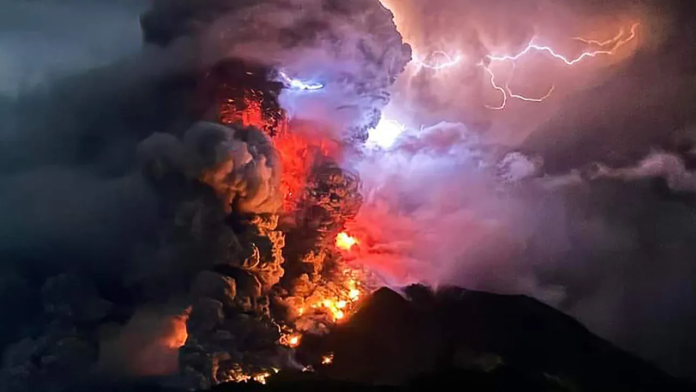By Aarav Sapra
Mount Ruang in Indonesia underwent a massive explosion last week, with volcanic gasses reaching up to the stratosphere. According to satellites, the Mount Ruang eruption created piles of ash plumes and volcanic gasses up to approximately 65,000 feet in the air. These will start to impact the weather and climate, potentially reducing atmospheric transparency and causing cooling due to the gasses emitted into the high atmosphere. In addition, volcanic ash is typically a mixture of crushed-up solids, including rocks, minerals and glass, and gasses, such as water vapor, carbon dioxide, and sulfur dioxide. Likely, the volcano won’t influence clouds and rain for long. The volcano erupted at about 7:19 p.m. local time in Antara, and the national news agency later reported that the eruption displaced more than 800 people in nearby villages. Many are now relocating to community centers or taking shelter in churches. Furthermore, authorities have claimed that more materials, such as mats, blankets, cleaning materials, tents, and more shelters, are necessary for safety. Efforts are underway to provide these materials and ensure the safety and well-being of the affected population.
Indonesia is the world’s largest archipelago nation and spreads across the Ring of Fire, where tectonic plates are shifting and clashing, causing earthquakes and magma to spew out from the mantle. In addition, Mount Ruang is classified as a stratovolcano built up from explosive eruptions of lava, rock fragments, ash, and other properties. Furthermore, its last eruption was in 2002, when lava and ash spewed up into the atmosphere 17 miles. However, for a region like Indonesia, which has several volcanoes, it is common for this to happen. In previous years, several volcanoes have erupted, and in December of 2023, the bodies of 11 hikers were found on the slopes of Mount Merapi on the island of Sumatra during its eruption, more than 50 people were killed, and hundreds more were injured.
With the initial threat subsiding, authorities, in their diligent efforts, lowered the alert and assessed the damage. The closure at Sam Ratulangi Airport was lifted after rains helped clear volcanic ash from the runway. However, some residents remain evacuated as the volcano continued to show signs of some activity. In addition, officials have flagged the risk of a tsunami if parts of the mountain collapse into the ocean below. About 400 people were killed in a tsunami unleashed by a previous volcano eruption in 1871. Indonesian authorities, demonstrating their commitment to public safety, are still closely monitoring this situation, and evacuation plans are crucial for protecting lives in the face of these natural hazards.

